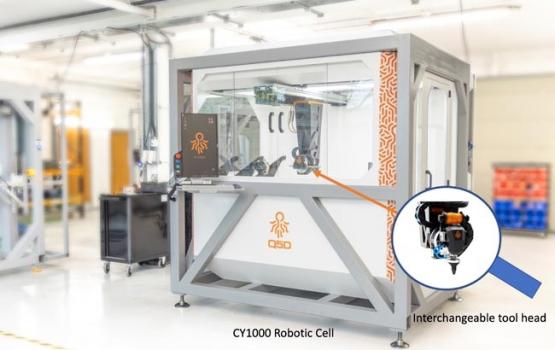CY1000 Wiring Harness Automation Cell

Description
The CY1000 5-axis CNC additive manufacturing robotic cell automatically, economically, and securely adds components, connections, and conductors into products or components made of metal, ceramic or polymer. The company calls its unique process 'Electrical Function Integration'. It eliminates the need for separate, expensive, fault-prone wiring harnesses, minimizes design constraints, improves reliability, and cut costs. The self-contained CY1000 manufacturing cell means that wiring can be co-located with the final assembly, eliminating the costly transportation of heavy harnesses.
With a steel-frame gantry and robotic platform, it's designed for stand-alone use or for easy integration as part of a process line, where it offers full-depth access for robotic loading. Each machine can use a variety of specialized tools to add bare or insulated wire and extrude a wide range of polymers from Nylon to PEEK and Kydex. It can also pick and place electrical connectors and components. The CY1000 creates 3D shapes, adds components, and connects them to each together with precision integrated wiring.
Large components or parts (up to 3ft (1 m) in diameter), or multiple smaller parts, can be formed by molding, stamping, or other traditional methods before being loaded into the manufacturing cell, which locates the part and adds electrical functions as specified by the designer using a CAD/CAM based on Siemens NX, but with a bespoke motion controller, post-processor, simulator, and other tools.
The working area is 3 ft (1 m) in diameter and 12 in. (300 mm) in height. The X and Y axes operate at 3 ft/s (1 m/s), the Z axis at 1.5 ft/s (0.5m/s), and the head and bed axes move at up to 70 rpm. The machine is controlled via a touch screen and keyboard. In addition to control functions, the screen provides an overview of the manufacturing platform status and performance, and displays productivity and quality data, if this is available.
The CY1000, which is customized for each application, is supplied with polymer and wiring end effectors. The wiring may be bare or insulated copper, up to 0.1 in. (3 mm) in diameter.
The company states that conductive ink end effectors will be available in Q3 2023.
Specs
- Insulated wire deposition
- Bare wire deposition
- Wire termination to connector
- Polymer deposition
- Printed electronics
- Pick and place connectors and small components
- Stand-alone design requires only power and an internet connection
- Tubular steel frame for rigidity and durability
- High-speed linear motors to maximize speed and productivity
- Steel and impact-resistant polymer cladding for safety and environmental control
- HEPA filtration of the internal environment
- Safety interlocked full-width door for loading, can be configured for co-acting robot loading
- Ergonomic operator station
- Accommodates continuous supply from external material warehouse
| Length | 91 in. (2,300 mm) |
|---|---|
| Depth | 87 in. (2,200 mm) |
| Height | 91 in. (2,300 mm) |
| Weight | 2 t (2,000 kg) |
| Robot Arm Max. Travel Speed | 118 in/s (3,000 mm/s) |
| Build Volume Diameter | 39 in. (1,000 mm) |
| Build Volume Height | 20 in. (500 mm) |
| Max. Weight | 66 lb. (30 kg) |
| Axis | Stroke | Max. Speed | Max. Acceleration | Accuracy | Repeatability |
|---|---|---|---|---|---|
| X | 59 in. (1,500 mm) | 3 ft/s (1 m/s) | 33 ft/s2 (10 m/s2) | ±5 µm | ±2 µm |
| Y | 41 in. (1,050 mm) | ||||
| Z | 30 in. (750 mm) | 1.5 ft/s (0.5 m/s) | 26 ft/s2 (8 m/s2) | ||
| B (head) | 240-deg. | 200 rpm | 200 rpm2 | ±30 arc sec | ±10 arc sec |
| C (bed) | 360-deg. Continuous Rotation | ±10 arc sec | ±5 arc sec |
| Hollow B and C Motor | ||
|---|---|---|
| Mass | <7 lb. (<3 kg) | <26 lb. (<12 kg) |
| Diameter | 5 in. (120 mm) | 6 in. (150 mm) |
| Total Length | ||
| Continuous Torque | 15 Nm | 100 Nm |
| Hollow shaft | 0.6 in. Ø (15 mm) | |
| Positional Accuracy | <30 arcsec | <10 arcsec |
| Repeatability | <10 arcsec | <5 arcsec |
